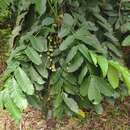Comments
(
Inglês
)
fornecido por eFloras
The seed oil is used for making soap and lubricating oil. The very fine wood is used for construction and ship-making.
- licença
- cc-by-nc-sa-3.0
- direitos autorais
- Missouri Botanical Garden, 4344 Shaw Boulevard, St. Louis, MO, 63110 USA
Description
(
Inglês
)
fornecido por eFloras
Trees or shrubs, (2-)20-30 m tall. Leaves odd- or even- pinnate, 30-60(-90) cm; leaflets (5-)9-21, opposite; petiolules (2-)6-12 mm; leaflet blades oblong-elliptic, elliptic, or ovate, (7-)17-26 × 4-10 cm with basal pair smallest, membranous when young, subleathery to leathery when mature, with visible transparent tiny spots under sunlight, both surfaces glabrous, secondary veins (8-)11-20 on each side of midvein and slender, base oblique and cuneate to broadly cuneate or sometimes one side rounded, margin entire, apex caudate-acuminate to obtuse. Inflorescences axillary, less than 30 cm. Flowers 6-7 mm in diam., with 3 bracteoles. Sepals 5, suborbicular, 1-1.5 mm in diam., margin sometimes ciliate. Petals 3-7 mm in diam., concave. Staminal tube globose, glabrous; anthers 5 or 6, oblong. Ovary 3-locular, with thick trichomes. Capsule spherical-pyriform to nearly ovoid, 2-2.5 × 2.5-3 cm, orangish when mature. Seeds grayish brown, oblate, 1.3-1.5 × 1-1.2 cm. Fl. May-Sep, fr. Oct-Apr.
- licença
- cc-by-nc-sa-3.0
- direitos autorais
- Missouri Botanical Garden, 4344 Shaw Boulevard, St. Louis, MO, 63110 USA
Habitat & Distribution
(
Inglês
)
fornecido por eFloras
Dense or sparse mixed evergreen broad-leaved and deciduous forests in mountainous regions; low to middle elevations. Fujian, Guangdong, Guangxi, Hainan, Taiwan (Lan Yu), Yunnan [Bhutan, India, Indonesia, Laos, Malaysia, Papua New Guinea, Philippines, Sri Lanka, Thailand, Vietnam; Pacific islands (Solomon Islands)].
- licença
- cc-by-nc-sa-3.0
- direitos autorais
- Missouri Botanical Garden, 4344 Shaw Boulevard, St. Louis, MO, 63110 USA
Synonym
(
Inglês
)
fornecido por eFloras
Aglaia polystachya Wallich in Roxburgh, Fl. Ind. 2: 429. 1824; A. aphanamixis Pellegrin; Amoora elmeri Merrill; A. grandifolia (Blume) Walpers; A. rohituka (Roxburgh) Wight & Arnott; Andersonia rohituka Roxburgh; Aphanamixis elmeri (Merrill) Merrill; A. grandifolia Blume; A. rohituka (Roxburgh) Pierre; A. sinensis F. C. How & T. C. Chen; A. tripetala (Blanco) Merrill; Chuniodendron spicatum Hu; C. yunnanense Hu; Trichilia tripetala Blanco.
- licença
- cc-by-nc-sa-3.0
- direitos autorais
- Missouri Botanical Garden, 4344 Shaw Boulevard, St. Louis, MO, 63110 USA
Aphanamixis polystachya
(
Inglês
)
fornecido por wikipedia EN
Aphanamixis polystachya, the pithraj tree, is a species of tree in the family Meliaceae. It is native to India, Pakistan, Nepal, Bhutan, Bangladesh, Myanmar and Sri Lanka.[3] It is a widely used as a medicinal plant in Ayurveda.[4]
Description
The Bengali name of the tree is royna (রয়না). Another name of this tree is pithraj (পিথরাজ). Oil is not edible and can be used as biodiesel and lighting. The very fine wood is used for construction and ship-making. The tree is 20m tall. Leaves are compound, imparipinnate, alternate; oblong-lanceolate, apex acuminate; base asymmetric; with entire margin. Flowers are polygamous and show panicles inflorescence. Fruit is a single seeded pale-reddish subglobose capsule.[5]
Common names
- Assamese—hakhori bakhori
- Bengali—tiktaraj, pitraj(রয়না)
- English—rohituka tree
- Hindi—harin-hara (हरिनहर्रा), harinkhana
- Kannada—mukhyamuttage, mullumuttaga, mulluhitthalu, roheethaka
- Khasi—dieng rata
- Kuki—sahala
- Malayalam—chemmaram, sem
- Manipuri—হৈৰাঙখোঈ heirangkhoi
- Marathi—raktharohida (रक्तरोहिडा')
- Rongmei—agan
- Sanskrit—anavallabha, ksharayogya, lakshmi, lakshmivana, lohita
- Sinhala—higul [6][7]
- Tamil—malampuluvan, sem, semmaram
- Telugu—chevamanu, rohitaka
Chemistry
The fruit shell contains triterpenes, aphanamixin. The bark contains tetranortriterpene, and aphanamixinin. The leaves contain diterpene, alcohol, aphanamixol and β-sitosterol. The seeds yield a limonoid, rohitukin, polystachin and others, an alkaloid, a glycoside and a saponin. A chromone and three flavonoid glycosides have been reported from the roots.[8]
References

- licença
- cc-by-sa-3.0
- direitos autorais
- Wikipedia authors and editors
Aphanamixis polystachya: Brief Summary
(
Inglês
)
fornecido por wikipedia EN
Aphanamixis polystachya, the pithraj tree, is a species of tree in the family Meliaceae. It is native to India, Pakistan, Nepal, Bhutan, Bangladesh, Myanmar and Sri Lanka. It is a widely used as a medicinal plant in Ayurveda.
- licença
- cc-by-sa-3.0
- direitos autorais
- Wikipedia authors and editors

